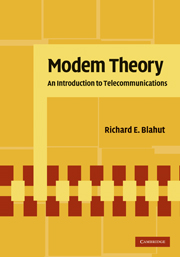Book contents
- Frontmatter
- Contents
- Preface
- Dedication
- 1 Introduction
- 2 Baseband Modulation
- 3 Baseband Demodulation
- 4 Sequences at Baseband
- 5 Passband Modulation
- 6 Passband Demodulation
- 7 Principles of Optimal Demodulation
- 8 Synchronization
- 9 Codes for Digital Modulation
- 10 Codes for Data Transmission
- 11 Performance of Practical Demodulators
- 12 Secure Communications
- Bibliography
- Index
9 - Codes for Digital Modulation
Published online by Cambridge University Press: 05 June 2012
- Frontmatter
- Contents
- Preface
- Dedication
- 1 Introduction
- 2 Baseband Modulation
- 3 Baseband Demodulation
- 4 Sequences at Baseband
- 5 Passband Modulation
- 6 Passband Demodulation
- 7 Principles of Optimal Demodulation
- 8 Synchronization
- 9 Codes for Digital Modulation
- 10 Codes for Data Transmission
- 11 Performance of Practical Demodulators
- 12 Secure Communications
- Bibliography
- Index
Summary
Rather than modulate one data symbol at a time into a channel waveform, it is possible to modulate the entire datastream as an interlocked unit into the channel waveform. The resulting waveform may exhibit symbol interdependence that is created intentionally to improve the performance of the demodulator. Although the symbol interdependence does have some similarity to intersymbol interference, in this situation it is designed deliberately to improve the minimum euclidean distance between sequences, and so to reduce the probability of demodulation error.
The methods developed in Chapter 4 for demodulating interdependent sequences led us to a positive view of intersymbol interdependence. This gives us the incentive to introduce intersymbol interdependence intentionally into a waveform to make sequences more distinguishable. The digital modulation codes that result are a form of data transmission code combined with the modulation waveform. The output of the data encoder is immediately in the form of an input to the waveform channel. The modulator only needs to apply the proper pulse shape to the symbols of the code sequence.
In this chapter, we shall study trellis-coded modulation waveforms, partial-response signaling waveforms, and continuous-phase modulation waveforms. Of these various methods, trellis-coded modulation is the more developed, and is in widespread use at the present time.
Partial-response signaling
The simplest coded-modulation waveforms are called partial-response signaling waveforms. These coded waveforms can be motivated by recalling the method of decision feedback equalization.
- Type
- Chapter
- Information
- Modem TheoryAn Introduction to Telecommunications, pp. 299 - 348Publisher: Cambridge University PressPrint publication year: 2009



